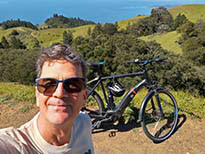* * *
In honor of the special day I decided to visit the planet Earth, and an especially lovely corner of it situated on the outskirts of the town of Larkspur near the base of Mt. Tamalpais. The place is called Baltimore Canyon.
When my family moved away from Hawaii the first time, I was about seven years old, and we went from Honolulu to Towson, just outside Baltimore, Maryland. It was the year of the "blizzard of '66" for this Island boy, and I still remember two years later worrying about my father as he drove off to work in Baltimore during the riots that broke out after the assassination of Martin Luther King, Jr., in 1968 .
So how, you might ask, did the name of Baltimore end up in this pretty little canyon at the base of Mt. Tam? According to a Wikipedia entry on Larkspur Creek, a sawmill was transported down the east coast of North and South America, around Cape Horn, then up along the west coasts of those two continents -- all the way from Baltimore to Larkspur -- in 1849:
Secretary Daniel Taylor of the Baltimore and Frederick
Trading and Mining Company recalled in a 1914 newspaper article, “When we
arrived at Larkspur, there was no one to meet us. The country was a wilderness,
with wild geese in abundance." The sawyers denuded Mt. Tamalpais of
old-growth redwoods in short order. Said Taylor in 1914, "I can picture
the majestic redwoods that covered the flat where Larkspur stands today. Some
of the trees were eight feet in diameter and lifted their immense bulk 300 feet
upward.”
You can still find a few redwoods along Larkspur Creek. In the photo above that shows multiple trunks rising in a kind of circle together, my guess is that they are all sprouting from the same burl, or underground fruiting structure, that once supported a single giant redwood. Larkspur is no longer a wilderness, but it seemed like a cute little town as I drove through it.
I got a stiff neck looking for California spotted owls but didn't have any luck. I photographed this semi-snoozing owl about this time two years ago.
I was surprised to see a fruiting of Panus conchatus on a decaying bay laurel that had fallen across the creek. I didn't even notice the slug gnoshing on the old specimen until I viewed the image back at home.
I drove out of Larkspur along Magnolia Avenue to Sir Francis Drake, then out to Fairfax-Bolinas Road which finally reopened earlier this month. This velvet-antlered buck was grazing on the edge of the road across from the Meadow Club Golf Course.
This might have been his younger brother, kicking back. It was great to see so many deer out and about again. Seems like it's been a while.
Up near Azalea Hill, a California poppy emerged from its tissue-like calyx.
Several cream cups (Platystemon
californicus), bloomed around their orange brothers in the Papaveraceae.
Due to the road being closed most of the winter, I hadn't been to the Lily Pond in ages. The non-native lilies were in bloom, but I was more interested in these slime mold fruiting bodies, which I presume to be wolf's milk (Lycogala epidendrum). There were a few bright red spots nearby which apparently is what the slime mold looks like in its plasmodial stage. Now I'm sorry I didn't photograph them.
A little farther down the trail I found a nice fruiting of spotted coralroot (Corallorhiza maculata), a plant that doesn't produce chlorophyll. Instead of photosynthesizing, this member of the orchid family parasitizes the mycelium of fungi in the Russulaceae. Now that I think about it, there were quite a few black-spotted banana slugs in the same vicinity. One of the slugs was feeding on a very old, entirely black and decayed mushroom that was probably among the last of the above-ground fruitings of a russula.
As I walked back toward the car, this little Pacific chorus frog hopped across the trail and landed on a log that seemed a perfect match for its camouflage. I fired off two frames before it hopped off and scuttled into a nearby pool of water where it disappeared.
Once again, another happy day on planet Earth.
* * *




























































